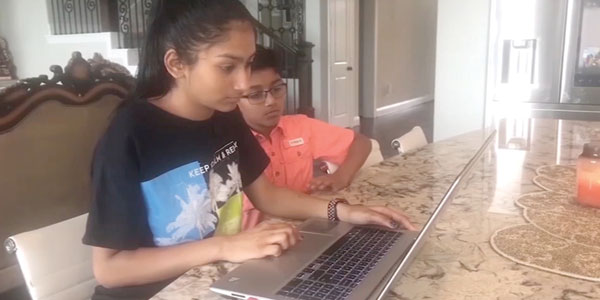
Some K-12 students are thriving since classes resumed. Other students aren’t; in fact educators and sociologists warn that we’re failing a worrying number of students. At the start of the 2020-2021 school year, there are necessarily new models in place from entirely remote instruction to hybrid combinations of in-person and online learning to fully in-person school attendance.
Students’ pandemic era academic progress depends on many factors — their personal ability to adapt to virtual instruction or hybrid models of in-person and online learning, the level of support they have at home and their own motivation and determination. However, varying degrees of digital access, Internet connectivity and inexperience with digital technologies present challenging obstacles beyond students’ control.
There are 15 to 16 million K-12 students in the U.S. living in households without adequate internet access or computing devices to facilitate distance learning, according to a June 2020 Common Sense Media study. These inequitable circumstances further widen already alarming gaps in educational opportunity and achievement.
Astonishingly, there are students whose appetite for learning compels them to get really creative to overcome obstacles to learning remotely. Two little girls in Salinas, Calif., have come to symbolize disparities exacerbated by the pandemic and the digital divide, to the wholesale disadvantage of millions of K-12 students.
The now-viral image of the little girls was first shared on Instagram in late August. It shows the determined students sitting on a curb with their laptops outside a local Taco Bell in order to use the restaurant’s free WiFi. They were doing their homework.
Their Salinas City Elementary School District identified them and provided their family with a “hotspot,” multiple media outlets have reported. Additionally, a GoFundMe campaign has raised more than $145,000 for the girls’ family. Because of their dedication, “these little girls deserve a safe space to learn,” wrote Jennifer Lopez, who started the fundraising campaign.
The girls’ family had been evicted from their home, local TV news stations reported. Their mother, identified as Juana Valencia Garcia told reporters that her daughters had gone to the Taco Bell because they wanted to study. The family has since received tremendous support. Besides the money raised online, they have “a new place to stay.”
Garcia is grateful for all the help and support, and she hopes that her family’s story will “bring help to others, too.”
We need to push for digital access because the internet is no longer an option; it’s an essential part of instruction and work, say education experts. Local, state and federal officials agree; we must close the digital divide once and for all for the sake of all students, they assert.
Key findings in the Common Sense Media study leave little room for argument. “Lack of access to the internet and a distance learning device during the coronavirus pandemic school closures puts students at risk of significant learning loss.”
Nota bene:
Read the Common Sense Media study online at https://www.commonsensemedia.org/about-us/news/press-releases/k-12-student-digital-divide-much-larger-than-previously-estimated-and
_____________________________________________________________________________
Eliminar la brecha tecnológica para los estudiantes
Algunos estudiantes de K-12 están prosperando desde que se reanudaron las clases. Otros estudiantes no lo están; de hecho, los educadores y los sociólogos advierten que estamos reprobando a un número preocupante de estudiantes. Al comienzo del año escolar 2020-2021, necesariamente existen nuevos modelos, desde la instrucción completamente remota hasta combinaciones híbridas de aprendizaje presencial y en línea, hasta la asistencia escolar completamente presencial.
El progreso académico de los estudiantes en la era de la pandemia depende de muchos factores: su capacidad personal para adaptarse a la instrucción virtual o modelos híbridos de aprendizaje en persona y en línea, el nivel de apoyo que tienen en casa y su propia motivación y determinación. Sin embargo, diversos grados de acceso digital, conectividad a Internet e inexperiencia con las tecnologías digitales presentan obstáculos desafiantes más allá del control de los estudiantes.
Según un estudio de junio de 2020 de Common Sense Media, hay entre 15 y 16 millones de estudiantes de K-12 en Estados Unidos que viven en hogares sin acceso adecuado a Internet o dispositivos informáticos para facilitar el aprendizaje a distancia. Estas circunstancias inequitativas amplían aún más las brechas ya alarmantes en cuanto a oportunidades y logros educativos
Sorprendentemente, hay estudiantes cuyo apetito por aprender los impulsa a ser realmente creativos para superar los obstáculos para aprender de forma remota. Dos niñas pequeñas en Salinas, California, han llegado a simbolizar las disparidades exacerbadas por la pandemia y la brecha digital, en gran desventaja para millones de estudiantes de K-12.
La imagen ahora viral de las niñas se compartió por primera vez en Instagram a fines de agosto. Muestra a las estudiantes decididas sentadas en una acera con sus computadoras portátiles afuera de un Taco Bell local para usar el WiFi gratuito del restaurante. Estaban haciendo sus deberes.
El Distrito Escolar Primario de la Ciudad de Salinas las identificó y le brindó a su familia un “punto de acceso”, han reportado varios medios de comunicación. Además, una campaña de GoFundMe ha recaudado más de $145,000 para la familia de las niñas. Debido a su dedicación, “estas niñas merecen un espacio seguro para aprender”, escribió Jennifer López, quien inició la campaña de recaudación de fondos.
La familia de las niñas había sido desalojada de su hogar, reportaron las estaciones de noticias de televisión locales. Su madre, identificada como Juana Valencia García, dijo a los periodistas que sus hijas habían ido al Taco Bell porque querían estudiar. Desde entonces, la familia ha recibido un gran apoyo. Además del dinero recaudado en línea, tienen “un nuevo lugar donde quedarse”.
García está agradecida por toda la ayuda y el apoyo, y espera que la historia de su familia “también ayude a los demás”.
Necesitamos impulsar el acceso digital porque el internet ya no es una opción; es una parte esencial de la instrucción y el trabajo, dicen los expertos en educación. Los funcionarios locales, estatales y federales están de acuerdo; debemos cerrar la brecha digital de una vez por todas por el bien de todos los estudiantes, afirman.
Los hallazgos clave del estudio Common Sense Media dejan poco espacio para la discusión. “La falta de acceso a Internet y un dispositivo de aprendizaje a distancia durante el cierre de escuelas por la pandemia del coronavirus pone a los estudiantes en riesgo de una pérdida significativa de aprendizaje”.
Nota bene:
Lea el estudio de Common Sense Media en línea en https://www.commonsensemedia.org/about-us/news/press-releases/k-12-student-digital-divide-much-larger-than-previously-estimated-and









